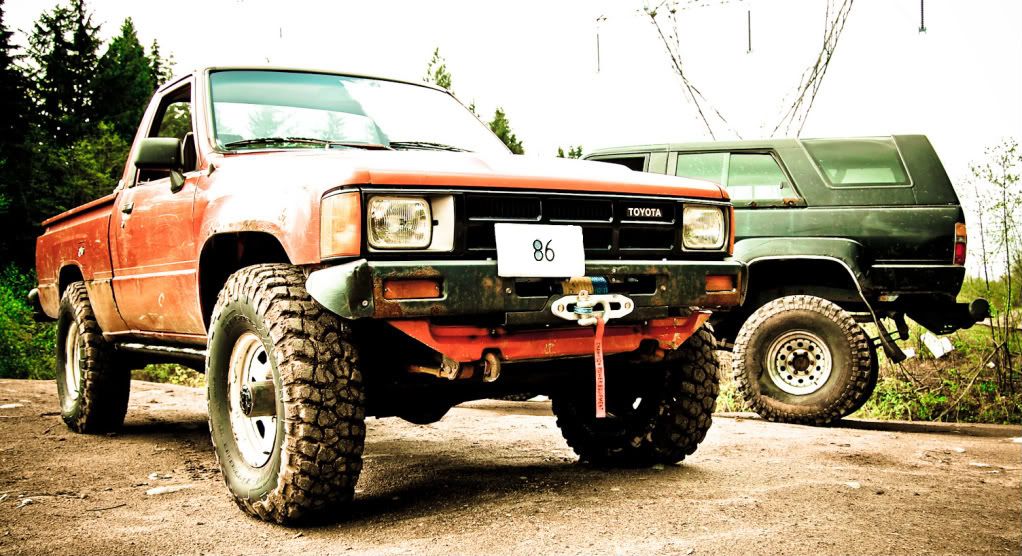Not too many people (myself included) go through the time and expense of tuning the spring rate and shock valving on both ends of a vehicle (remember, proper ride height does not equal proper spring rate). We typically work with what is readily available - which means we work with springs and shock valving that were produced for what someone else thinks that the masses use. Since the masses don't use truck campers, the suspension manufacturers don't make much for those who do.
I should point out that I do in fact have the time, ability, facilities, motivation, and budget (at least for non-fancy hardware) to do exactly this, as well as any other tuning and fabrication that may be required. This project has the full weight and significance of a gearhead's Project, with a capital P; I'm not just throwing together whatever's readily available. At least not for the vehicle side of the project.
You didn't mention if you were planning on having your camper permanently mounted.
Yep, permanently. I'm cutting a hole in the back of the cab, building a 5-sided insulated box to call the "cabin", and coming up with somekinda heavyduty flexible seal between the cabin and the cab.
My plan was to put it on these 1655-pound Ford springs I've got (stock Yotas are 1100# and that's payload, not including the substantial empty weight difference between a F250 and a Hilux), load it with all the stuff I intend to carry, put each axle on a scale, and only then buy shocks and possibly spring parts to match.
You're talking about building a camper on the back, independent of the cab (even if you try to tie it together it is more or less independent). Riding down washboard roads, bad highways, expansion joints etc it creates an upset in the chassis as the two units (cab and camper) move in opposite direction and create bucking or porpoising as the frame flexes. If the majority of the weight is forward of the axle it tends to move together more. The chassis and suspension is designed to carry most of the weight in the middle, rather than behind the axle.
I hear you about the porpoising; that's something I've experienced in convertibles and I don't care for it. I calculated the CG of the rear-closet cabin with longer wheelbase to be somewhat ahead of the rear axle, but not by much.
Here's a picture of my truck and camper that I sold last spring...
... I saw lots of toyotas with pop-ups (with good center of gravity) porpoise terribly on the same roads due to weaker frames, you could watching the cab/bed move independently. All in all it wasn't terrible but it was far from ideal. Keeping that weight forward would have made a huge difference.
I should point out that mine's a singlecab (and a very small cab at that) and I am tuning up the rear suspension to handle it. Toyota axles are strong enough, but you're right, the frames are lighter and flimsier than domestic iron. One similar to mine cracked the frame in two by hitting a dip with some good speed. That was with a lot of weight and admittedly very rough use, but the wheelbase was stock like mine.
US-market Toyota Hilux/Pickup wheelbases:
79-83 had short-frames and long-frames. All were singlecabs and the difference is in the bed: 6' or 7'. Shorts are about 103", longs 2850mm (~111")
84-88 had short-frames, long-frames, and a couple of different extra-long frames. Short frames were 6' bed singlecabs and 4Runners, also about 103". Long frames were either 7' bed singlecabs or 6' bed extra-cabs, about 112". All extra-longs (116, 122, 132", IIRC...) are 2wd-only and mostly chassis/cab trucks with 1-ton dually rear axles.
89-95 had something similar going on, same 103" for the shorts, except the long wheelbase was about 122" (extracab shortbeds, and a few rare singlecab longbeds).
For your buildup I'd do a high clearance trans crossmember and then not worry too much about belly clearance. Just put armour or skids on everything plus a winch in the nose and don't worry about it.
Not to get sidetracked by technicalities of the chassis, but I think the stock trans crossmember is fully boxed for a reason; I can't imagine the Budbuilt one 1. being half as durable if taking an impact, 2. stiffening the frame nearly as well.
Cool truck you've got! I see you're of the tall/skinny school of thought on off-road tires?
IMHO the most important parameters are departure angle and weight distribution. Breakover angle is secondary and is mitigated by big tires and adequate suspension. Please read pertinent portions of:
http://www.xor.org.uk/silkroute/equipment/choosevan.htm
That is a great link, thanks! Reading it is keeping me busy for a while. It's reassuring that while I've never done quite this before, all of the sub-topics it mentions have been given some good attention in my own planning files. This thing's been a paper project for nearly two years. I've had the chassis to build on since last March, and all I've done is rebuild the front axle and take the bed off to do measurements.


